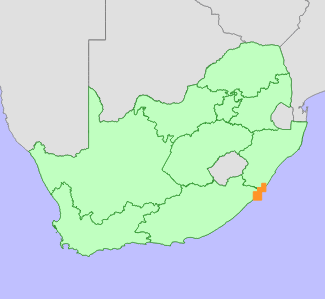|
Scientific Name | Manilkara nicholsonii A.E.van Wyk |
Higher Classification | Dicotyledons |
Family | SAPOTACEAE |
Common Names | Pondo Milkberry (e) |
National Status |
Status and Criteria | Endangered B1ab(iii,v); C2a(i) |
Assessment Date | 2007/11/27 |
Assessor(s) | L. von Staden, A.E. van Wyk, C.R. Scott-Shaw, A.T.D. Abbott & J.E. Victor |
Justification | EOO 1400 km², small, severely fragmented subpopulations consisting of no more than 10 mature individuals continue to decline due to too frequent and intense grassland fires affecting forest margins. The population is estimated to consist of fewer than 2000 mature individuals. Due to widespread parasitisation of flowers, fruit set is very poor and recruitment and dispersal is limited. |
Distribution |
Endemism | South African endemic |
Provincial distribution | Eastern Cape, KwaZulu-Natal |
Range | Mzimkhulu River to Msikaba River. |
Habitat and Ecology |
Major system | Terrestrial |
Major habitats | Eastern Valley Bushveld, Northern Coastal Forest, Scarp Forest, Pondoland-Ugu Sandstone Coastal Sourveld |
Description | Pondoland scarp forest. Occurs on the margins of drier forests, especially along the upper edge of cliffs above the deep forested gorges, as well as along the margins of kloof forests. |
Threats |
| The main threats to Pondoland woody endemics restricted to forest margins are too frequent and intense grassland fires that are causing forest margins to recede (D. Styles, C.R. Scott-Shaw pers. obs.) as well as the indiscriminate harvesting of wood for fuel and building materials (T. Abbott pers. comm.) These threats are affecting forest margins mainly in the areas between Umtamvuna and Mkambati Nature Reserves.
From Port Edward to Oribi the largest remaining areas of forest are fairly well protected within the Umtamvuna and Oribi Gorge Nature Reserves, however, some areas of forest above the edges of these deep gorges have undoubtedly been cleared for forestry and agriculture (mainly sugarcane) in the past.
Smaller forest patches outside of reserves are threatened by the effects of fragmentation and isolation within a transformed landscape as well as alien invasive encroachment.
Flowers of this species are attacked by a parasitizing insect. This leads to extremely poor fruit set, and as a result recruitment is very poor. Seedlings and juveniles are absent from most subpopulations (Scott-Shaw 1999). Seedlings are extremely rare, but are occasionally found (see photo by T. Abbott in Pooley 1998). Unlike other Pondoland species suffering poor recruitment, vegetative reproduction have not been observed in M. nicholsonii. Poor recruitment in combination with serious threats to the habitat may cause this species to decline to extinction within a very short period. |
Population |
Population trend | Decreasing |
Notes |
| Displays form of reproductive failure in which the majority of flowers transform into galls and fruits are rare. Most Manilkara species have densely furry ovary, but this species is glabrous and therefore susceptible to parasite infestation. This species may be a relict from the time when it existed without the pressure of insects/parasites (A.E. van Wyk pers. comm.). |
Assessment History |
Taxon assessed |
Status and Criteria |
Citation/Red List version | | Manilkara nicholsonii A.E.van Wyk | EN B1ab(iii,v); C2a(i) | Raimondo et al. (2009) | | Manilkara nicholsonii A.E.van Wyk | EN | Scott-Shaw (1999) | | Manilkara nicholsonii A.E.van Wyk | Endangered | Hilton-Taylor (1996) | |
Bibliography |
Boon, R. 2010. Pooley's Trees of eastern South Africa. Flora and Fauna Publications Trust, Durban.
Hilton-Taylor, C. 1996. Red data list of southern African plants. Strelitzia 4. South African National Botanical Institute, Pretoria.
Pooley, E. 1998. The complete field guide to trees of Natal, Zululand and Transkei. Natal Flora Publications Trust, Durban.
Raimondo, D., von Staden, L., Foden, W., Victor, J.E., Helme, N.A., Turner, R.C., Kamundi, D.A. and Manyama, P.A. 2009. Red List of South African Plants. Strelitzia 25. South African National Biodiversity Institute, Pretoria.
Scott-Shaw, C.R. 1999. Rare and threatened plants of KwaZulu-Natal and neighbouring regions. KwaZulu-Natal Nature Conservation Service, Pietermaritzburg.
|
Citation |
| von Staden, L., van Wyk, A.E., Scott-Shaw, C.R., Abbott, A.T.D. & Victor, J.E. 2007. Manilkara nicholsonii A.E.van Wyk. National Assessment: Red List of South African Plants version 2024.1. Accessed on 2025/11/30 |
 Comment on this assessment
Comment on this assessment

